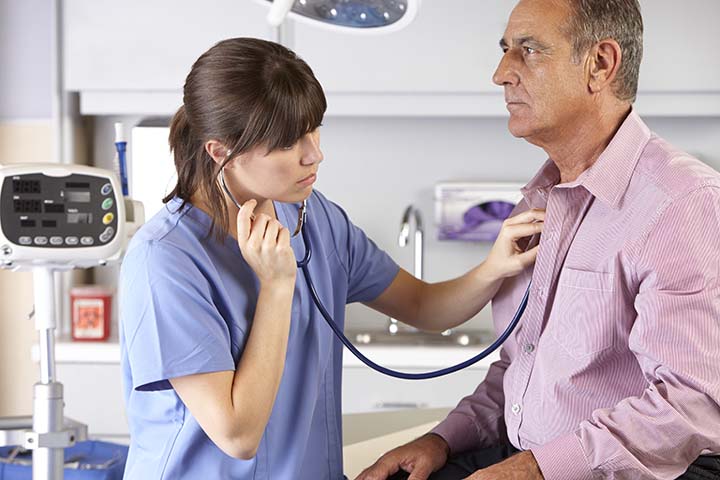4 Dec 2020
Prostate Cancer: How to Protect Yourself from Myths and Misconceptions
Estimated read time: 9 minutes, 55 seconds
Prostate cancer is a silent and very dangerous enemy. In the United States, it is the third-most common type of cancer, behind breast and lung cancer. In Latin America, it’s the most common. Despite its prevalence, people know little about it, and there are many myths, misconceptions and misinformation surrounding it.
Millions of people suffer from prostate cancer each year. It is one of the most common types of tumors and represents a serious health threat due to how dangerous, silent, and elusive it is. Sometimes it can take a long time before patients notice its effects and detect its presence, which makes the symptoms worse.
This delay is often due to the misinformation, rumors, falsehoods, and myths surrounding this illness.
What is prostate cancer?
The prostate is a gland only males have. It is located just below the bladder and has the function, among others, of producing part of the liquid that makes up semen. With age, the prostate tends to grow, causing conditions like prostatitis. In addition, it can cause tumors or cancers that are very dangerous. In the United States, prostate cancer is considered to be the third-most frequent form of cancer, behind breast and lung cancer. In 2019, the American Cancer Society reported more than 174,000 cases of prostate cancer, with 31,620 resulting in death. This means that one in nine men in the United States will be diagnosed with this illness at some point in their lives.
In Latin America, on the other hand, prostate cancer is even more harmful. It is as common as breast and lung cancer and is the cause of tens of thousands of deaths each year, which is exacerbated by low detection rates in Latin American countries.
Like all types of cancer, prostate cancer is caused by cell mutation. At a specific moment, which can occur spontaneously or be caused by an underlying environmental or hereditary factor, an error occurs when cells are reproducing, and they begin to grow uncontrollably.
Prostate cancer causes pain, difficulty urinating, erectile dysfunction, blood in urine or semen, back, hip or thigh pain, and other serious symptoms. The tumors can also metastasize into other vital organs, especially lymph nodes and bones.

In general, prostate tumors occur in men over the age of 50, and some of the underlying factors for the disease include diet and genetic predisposition.
Also, many men who develop it don’t notice the symptoms and do not receive treatment. On the other hand, there are also men who, despite the fact that they are aware of the symptoms, do not seek proper care due to a lack of information or false preconceived notions.
Myths and facts about prostate cancer
There are numerous myths, legends and rumors surrounding prostate cancer that contribute to possible patients being misinformed and consequently delaying seeking medical care and treatment. Here are some of the most dangerous misconceptions:
- Prostate cancer only occurs in elderly men. This is false. Thirty-five percent of cases detected each year are in men below the age of 65.
- It isn’t cancer if I don’t have symptoms. Prostate cancer is one of the most asymptomatic types of cancer. Sometimes there are no symptoms at all, or the symptoms may be attributed to another cause. The most common signs appear in the urinary tract and include difficulty or inability to urinate or pain when urinating. This can also commonly be attributed to other illnesses, which causes a prostate tumor to many times go undiagnosed.
- A slow-growing cancer isn’t dangerous. This is only true for some types of prostate cancer. There are actually around 30 types of prostate cancer, some of which are very aggressive and grow quickly. Only by carrying out a biopsy and analyzing the tissues can doctors determine what type of tumor it is and how it should be treated.
- It is a hereditary cancer. This is not true. Many people think that they won’t develop a prostate tumor because there haven’t been any cases in their family. Though it is true that a person with close family members (father or brothers) who have had it has a 50% higher probability of developing the disease, there are also a large number of cancer cases that occur there being any family history of it.
- PSA is a symptom of cancer. One of the most common tests for men over 45 is the PSA (prostate-specific antigen) test. This blood test detects high concentrations of this antigen, which could be a sign of prostate problems, but it is not necessarily a symptom of cancer.
- Treatments will cause impotence. Not always. Many men who undergo surgery to eliminate prostate tumors suffer from erectile dysfunction, but the large majority of them have a full recovery, and in two years can resume having a normal sex life.
- An enlarged prostate means I have cancer. Not always. It is frequent for men to have prostate inflammation for a variety of reasons. For example, benign prostatic hyperplasia, also known as prostate enlargement, causes significant swelling and is unrelated to cancer. Regardless, men should always seek medical care for an inflamed prostate.
- Frequent ejaculation reduces the risk of prostate cancer. One of the most widely-spread ideas about prostate cancer is that ejaculating at least 21 times a month reduces the risk of contracting it. Specialists have not reached a consensus on this, and there are studies that find there is no relationship between ejaculation and a lowered risk of developing a tumor.
- Having a vasectomy increases your risk of developing cancer. This is another myth. No proof has been found that this sterilization procedure is linked to a risk of developing prostate cancer.
All of these ideas commonly come up in conversations about this very serious disease, making it important to be able to separate fact from fiction.
Can prostate cancer be prevented?
Specialists say that there is no failsafe way to prevent prostate cancer. There are a number of risk factors, including age, race, and family history, which cannot be controlled. But there are some things men can do to reduce their risk.

- Quit smoking. Tobacco use is a significant risk factor. Men who quit smoking can significantly reduce their predisposition to this illness. It is estimated that men who have quit smoking for 10 years have the same probability of developing prostate cancer as those who never smoked.
- Exercise and lose weight. Being overweight and having a sedentary lifestyle are also well-known allies of prostate tumors. Activities like swimming, walking, jogging, or bike riding are ideal for maintaining an active lifestyle, losing weight, and lowering the possibility of suffering from one of these types of cancers.
- Eat healthy. Science is clear on this. Diet is one of the most decisive factors in being predisposed to having a prostate tumor. An unbalanced diet, rich in unhealthy fats and low in vitamins, may be linked to this disease.
- Doctors recommend eating a diet high in vegetables, especially tomatoes and other red produce, fruits, and food high in isoflavones, like tofu (made from soy milk), lentils, peanuts, and alfalfa and other sprouts.
- Choosing healthy fats is also important. It is recommended that you consume plant fats and food rich in acids like Omega-3 and at least two servings of fish (salmon, mackerel, trout or sardines) a week (about 3.5 ounces or 100 grams).
- It is also a good idea to consume folic acid, which is found in whole grains and dark green leafy vegetables, like spinach, asparagus, broccoli, chard and lettuce. On the other hand, it’s also important to reduce your consumption of dairy products and foods rich in calcium, like cheese.
- Lastly, experts recommend drinking coffee. Studies have shown that consuming high levels of caffeine reduces the risk of prostate cancer. However, consuming excessive amounts of caffeine can have adverse effects, such as difficulty sleeping and heart palpitations.
- Get checkups. Starting at the age of 45 or 50, men should schedule regular visits with their doctor and request a screening. Since many times prostate tumors are asymptomatic, they can only be found when they are specifically looked for.
Risks of taking herbs and supplements
Prescribed treatments may not always be particularly effective, leading men to seek other more natural methods, such as herbs and supplements. Some studies suggest that herbs and supplements can help in treating prostate cancer and supporting prostate health. Yet, there are concerns that they may have adverse interactions with prescribed medications. For example, they can amplify the effects of some medications or nullify the benefits of others.
One of the most common interactions is with St. John’s wort, which is taken to treat mild depression and affects the way the liver metabolizes certain medications. Other herbs, such as saw palmetto, and melatonin supplements, which some people take in the hopes that they will slow the spread of cancer, can cause an increased risk of bleeding when taken with other medications such as aspirin, ibuprofen, naproxen, blood thinners, or antiplatelet drugs.
One of the most widely-published studies about supplements and prostate cancer is the SELECT (Selenium and Vitamin E Cancer Prevention Trial), which analyzed the use of the supplements vitamin E and selenium.

However, in 2014 researchers found that high doses of vitamin E (400 IUDs/day) or selenium (200 micrograms/day) not only showed no benefit for men with a risk of developing prostate cancer, but that in certain cases, even increased their risk of high-grade prostate cancer by 91% after taking selenium supplements. In addition, taking vitamin E supplements also increased the overall risk of prostate cancer by 63%.
Herbs and supplements don’t work miracles, and although they can benefit some men with prostate disorders, it’s always important to ask a physician if they can be used as a complement in treating, managing and preventing this disease.
How is prostate cancer detected and treated?
One of the most frequent ways to detect prostate cancer is at doctor’s visits. Health professionals carry out routine exams of the urinary tract, where tumors in their initial phases, or already advanced but asymptomatic, can appear.
If patients have symptoms (pain, swelling, blood in urine or semen, difficulty urinating), doctors will carry out a series of tests, the most common of which include a digital rectal examination, blood and urine tests, biopsies and a PSA test. Recently, the APCP-2, or specific prostatic antigen test has been added to this.

Based on this, your doctor may do imaging tests (ultrasounds or other exploration methods) and contrast x-rays, and genetic testing to identify a genetic predisposition to the illness is also common.
Once the tumor has been diagnosed, treatment can begin, which many vary depending on the type of cancer, its stage and aggressiveness. Sometimes, if a tumor is very slow-growing, doctors may recommend keeping an eye on it and waiting without prescribing treatment. This is usually how it is treated in the very elderly.
Another way to attack it is through surgery by performing a prostatectomy (prostate extraction).
Today this operation is minimally invasive and is done using a laparoscopy, or even robotic surgeons. Like with other tumors, radiation and chemotherapy may also be used.
Additional techniques include hormone therapy, which aims to reduce levels of testosterone and other male hormones, which usually causes the cancer to grow more slowly. Innovative therapies are also being tested based on immunotherapy, which stimulates a patient’s immune system to better fight the cancer cells.
Prostate cancer is undoubtedly a significant problem affecting the lives of many men. Learning about it and recognizing its symptoms and avoiding misinformation and myths are the foundation for improving your odds of overcoming it.
Sources: American Cancer Society, “Cancer, Facts and Figures”; “Common questions about cancer, activity, and diet”; Immunotherapy for Prostate Cancer, JAMA Network, “Vitamin E and the Risk of Prostate Cancer: The Selenium and Vitamin E Cancer Prevention Trial (SELECT), Organización Panamericana de la Salud (OPS), “EL cancer en las Américas”, Harvard Medical School, “Prostate Cancer”, THE 5 MILLION DOLLAR TEST, National Cancer Institute, Folic acid and risk of prostate cancer: Results from a randomized clinical trial


